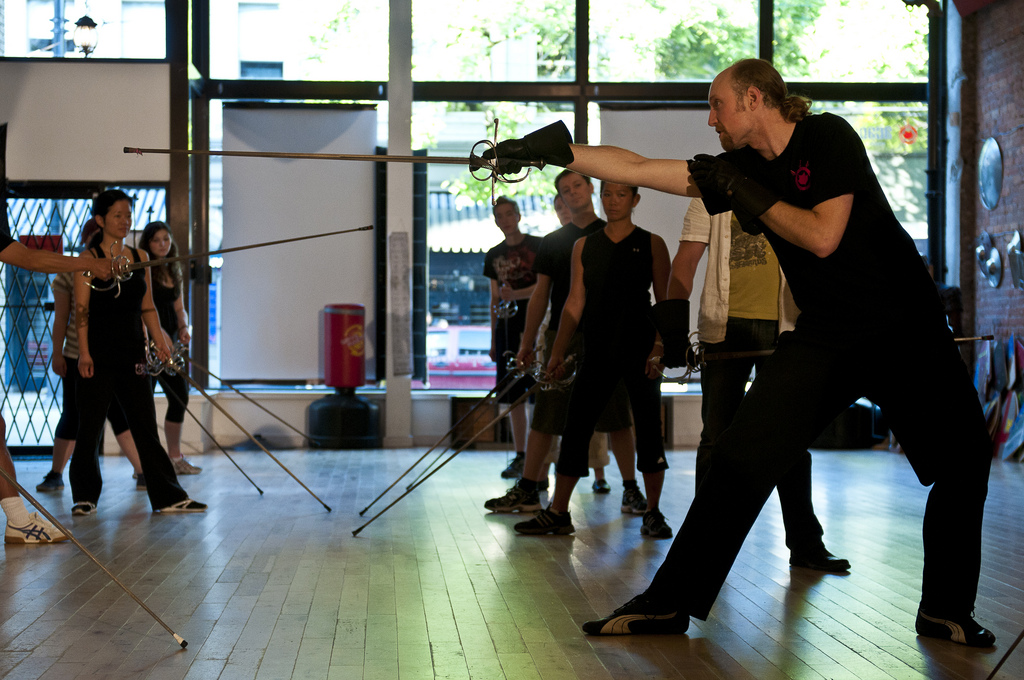I recently engaged in a Facebook discussion regarding Historical European Martial Arts (HEMA) specifically about whether training with sharp swords is responsible or not. This has been a discussion born primarily out of the work of Roland Warzecha of a school called Dimicator in Hamburg Germany who has recently incorporated use of sharps into his regular advanced student training exercises.
As with many things within the HEMA scene opinions on this practice vary widely and passions often run high. Many people have called the motivation for practicing with sharps into question.
Some unhealthy motivations for practicing with sharps:
1. Looking like a badass.
2. Giving yourself a thrill as you risk your safety and the safety of others.
3. Righteousness and politics. “I’m better and more authentic than you because I practice with sharps.”
I personally don’t find that sharp fencing/exercise is about trying to give me a thrill — and though there may be some seeking ego boosts or bungee jump thrills, Roland and many others who are using this training method are certainly seeking something much deeper and more useful.
All training methods have risks and bringing ego into your practicing is not only self-limiting but can also cause its own safety concerns.
Controlled and appropriately applied exercise with sharps can help you discover and explore the way a real sword moves and the way the edges find one another. Sure it’s not the same as bringing two weapons together with significant force, yet there are still many lessons to be learned here and many sword interactions come more subtly than a hard bash of edges. This is certainly the case in my understanding of I.33, rapier fencing, and even Italian longsword where authours describe coming gently and with suppleness to the bind.
It is important however to recognize the limitations of this type of exercise.
Some mislaid premises for practicing with sharps:
1. Practicing with sharps is the only way to understand true swordsmanship.
2. Slow and safe training with sharps simulates combat better than any other method.
Every form of training has its own limits and advantages. Saying that fencing with sharps in a slow and conscientious manner creates the most accurate training environment is obviously foolish. When you aren’t striking your opponent it makes it difficult to move with certain types of intention. When there is less force in the interaction the way the edges meet and nature of sword parries change. However when you train with blunt swords the interaction is also different; the change in risk to the nature of how the swords feel as they move through the air to the change in their edge interaction dynamic create inaccuracies. But you can also train with a different more direct intention, you can truly test the tactical environment and make sure you’re not creating a false sense of safety and timing by truly challenging your partner’s defence.
Can any form of training be done badly and with false premise? Sure. Can any form of training be done irresponsibly and foolishly? Yes. But lets not throw out the baby with the bathwater or assume that those who are training in this way must be doing it fool heartedly or with only ego in mind.
My recommendations for any method of training:
1. Know your martial goals and training goals. What type of martial artist do you want to be and what types of training are going to give you the best results for those goals?
2. Understand the pros, cons, realities, and artifacts of the training forms you choose. No form is perfect, know what each form can and cannot give you.
3. Be sure you understand the risks and train with those in mind as a mature adult.
Do I advocate that everyone go out and start training with sharps. Certainly not. I think for many there is no need at this point in their training and not everyone is ready to manage this type of risk. Is there a danger in introducing this idea to the world of HEMA practitioners, not all of whom are responsible adults? Perhaps but I think responsible discussion is one of the ways that we create responsible adults and I’d rather have the conversation openly and share positive ideas than try to create safety through silence.
Safe training everyone.
